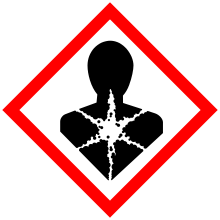Triptane
Not to be confused with triptan, a type of anti-migraine drug, Tryptan, a trade name of tryptophan, or triplane.
| |||
| Names | |||
|---|---|---|---|
| IUPAC name
2,2,3-Trimethylbutane[1] | |||
| Identifiers | |||
| 464-06-2 | |||
| 3D model (Jmol) | Interactive image | ||
| 1730756 | |||
| ChemSpider | 9649 | ||
| ECHA InfoCard | 100.006.680 | ||
| EC Number | 207-346-3 | ||
| PubChem | 10044 | ||
| UN number | 1206 | ||
| |||
| |||
| Properties | |||
| C7H16 | |||
| Molar mass | 100.21 g·mol−1 | ||
| Appearance | Colorless liquid | ||
| Odor | Odorless | ||
| Density | 0.693 g mL−1 | ||
| Melting point | −26 to −24 °C; −15 to −11 °F; 247 to 249 K | ||
| Boiling point | 80.8 to 81.2 °C; 177.3 to 178.1 °F; 353.9 to 354.3 K | ||
| Vapor pressure | 23.2286 kPa (at 37.7 °C) | ||
| Henry's law constant (kH) |
4.1 nmol Pa−1 kg−1 | ||
| Refractive index (nD) |
1.389 | ||
| Thermochemistry | |||
| 213.51 J K−1 mol−1 | |||
| Std molar entropy (S |
292.25 J K−1 mol−1 | ||
| Std enthalpy of formation (ΔfH |
−238.0 – −235.8 kJ mol−1 | ||
| Std enthalpy of combustion (ΔcH |
−4.80449 – −4.80349 MJ mol−1 | ||
| Hazards | |||
| GHS pictograms |     | ||
| GHS signal word | DANGER | ||
| H225, H304, H315, H336, H400 | |||
| P210, P261, P273, P301+310, P331 | |||
| EU classification (DSD) |
| ||
| R-phrases | R11, R38, R50/53, R65, R67 | ||
| S-phrases | (S2), S16, S29, S33 | ||
| NFPA 704 | |||
| Flash point | −7 °C (19 °F; 266 K) | ||
| 450 °C (842 °F; 723 K) | |||
| Explosive limits | 1–7% | ||
| Related compounds | |||
| Related alkanes |
|||
| Except where otherwise noted, data are given for materials in their standard state (at 25 °C [77 °F], 100 kPa). | |||
| Infobox references | |||
Triptane, or 2,2,3-trimethylbutane, is an organic chemical compound with the molecular formula C7H16 or (H3C-)3C-C(-CH3)2H. It is therefore an alkane, specifically the most compact and heavily branched of the heptane isomers, the only one with a butane (C4) backbone.
Triptane is commonly used as an anti-knock additive in aviation fuels.
References
- ↑ "Triptan - Compound Summary". PubChem Compound. USA: National Center for Biotechnology Information. 26 March 2005. Identification and Related Records. Retrieved 11 March 2012.
This article is issued from Wikipedia - version of the 10/23/2016. The text is available under the Creative Commons Attribution/Share Alike but additional terms may apply for the media files.


